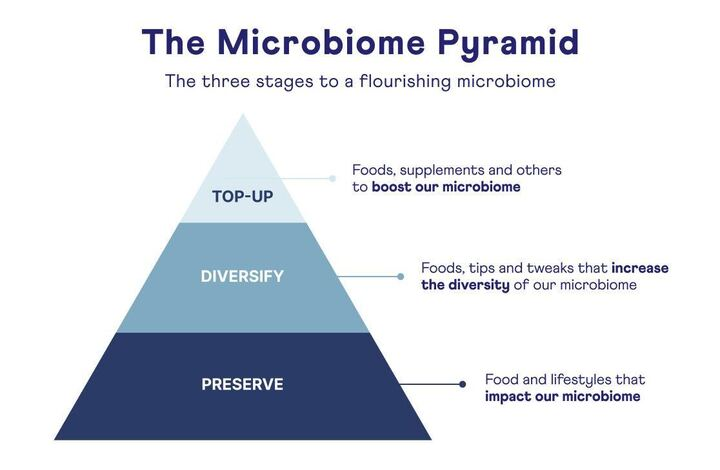

The microbiome can be a tricky thing to get our heads around—especially when confronted by Latin bacteria names (Adlercreutzia equolifasciens is at least 53 Scrabble points), barrages of technical terms (alpha & beta diversity) and shiny ads for tangy kombucha and garlicky kimchi.
But looking after your microbiome—the bacteria, fungi and even viruses that live in our guts, help us digest foods and care for our gut walls—can be pretty simple.
We often don’t need fancy tests to understand how our microbiomes and health interact. Even better, a lot of what we can eat to keep our microbiomes healthy is readily available, affordable and quite often not too fizzy or funky.
Here’s a quick primer on the microbiome:
We know that the diversity of your microbiome declines with age and poor health.
We know that diversity can be increased by maximising the types of food we eat, particularly vegetables.
We know that the microbiome actually does things—think of each bug like a very specialised worker that turns a specific part of a food into a specific chemical.
Sometimes these chemicals can be useful like short chain fatty acids, or SFCAs.
These SFCAs are produced by some bacteria, like Faecalibacterium praiznitzii, and they are vital for cellular health, from the gut lining to the depths of the coiled DNA of your brain's glial cells.
Other bacterial by-products, however, can be harmful like trimethylamine, or TMA, which we know can contribute to cardiovascular disease.
Why food underpins it all
I've tried all sorts of fermented foods in search of biome diversity.
I visited Japan to learn about the amazing fungus kōji, that is used most commonly to brew soy sauce and make miso. I’ve also played around with using koji to ferment my own ingredients, from cheese rinds to cherry stems.
Years later, I found myself in the Andes, helping make Chicha de Jora, a delicious bright gold fermented corn drink. The traditional method involves chewing and spitting maize out to kickstart the fermentation.
Despite the Pacific Ocean between them, these two recipes weren’t too different at all - using microorganisms and their enzymes to unlock nutrients and release flavour from ingredients.
And that’s the best bit: when you ferment food to unlock flavour you often release nutrients hidden inside. Fermentation in these traditional recipes served a fundamental role in preserving food and making nutrients more absorbable. So these dishes have evolved alongside us and stayed on our plates for a reason.
So I suggest thinking of the microbiome as a brilliant diverse city, each component doing their own important job to keep things chugging along.
This series is about what we can do about our microbiomes, focussing on the bits with evidence that are easy and affordable to take up as daily habits.
The Microbiome Pyramid is the way I think we should think about how to care for our microbiomes, and it looks like this:

PRESERVE—Many things we eat can reduce the diversity of our microbiomes or make them produce toxic substances that are harmful for our digestion and cells… In this section we will think about the foods that harm the microbiome and how we can even neutralise them in recipes!
DIVERSIFY—Once we’ve covered maintaining a healthy microbiome, we can consider ways to diversify it. You can do this without even changing what you eat and just perhaps the way you cook it…
TOP-UP—Supplementation can help diversify the microbiome—it involves probiotics, though there’s more! There are super important polyphenols & minerals to discuss that keep our gut bugs happy.
Looking after our microbiomes doesn’t need expensive tests or esoteric fermented foods.
Sure, they’re both nice—but you’d be surprised how far a cold slice of sourdough margherita pizza can take you too.
So next month we will start with Part 1… How to preserve our microbiome diversity and avoid things that we know can harm our brilliant bugs.
AND I’m going to do the whole thing without talking about kombucha. Not even once.
References
https://www.nature.com/articles/s41575-022-00605-x
https://www.nature.com/articles/s41591-020-01183-8
https://www.nature.com/articles/s41598-022-27086-x
https://www.nature.com/articles/nature09922
https://www.ncbi.nlm.nih.gov/pmc/articles/PMC9003261/
More about Dr Ramy
Dr Ramy Saad is a physician and researcher, focussing on the microbiome and epigenetics.
Ramy studied medicine at UCL and is a medical doctor in Clinical Genetics, with a background in Internal Medicine and Rheumatology.
Ramy’s scientific research has been around the impact of micronutrients, vitamins and polyphenols in inflammation and immunity and he has been published in New England Journal of Medicine and the American Journal of Clinical Nutrition. Ramy also holds academic and industry experience in nutrition, ingredient and supplement development and adapting medical policy.
Ramy is also the co-founder of kojikins.com, creating award-winning fermented sauces for homes and chefs.